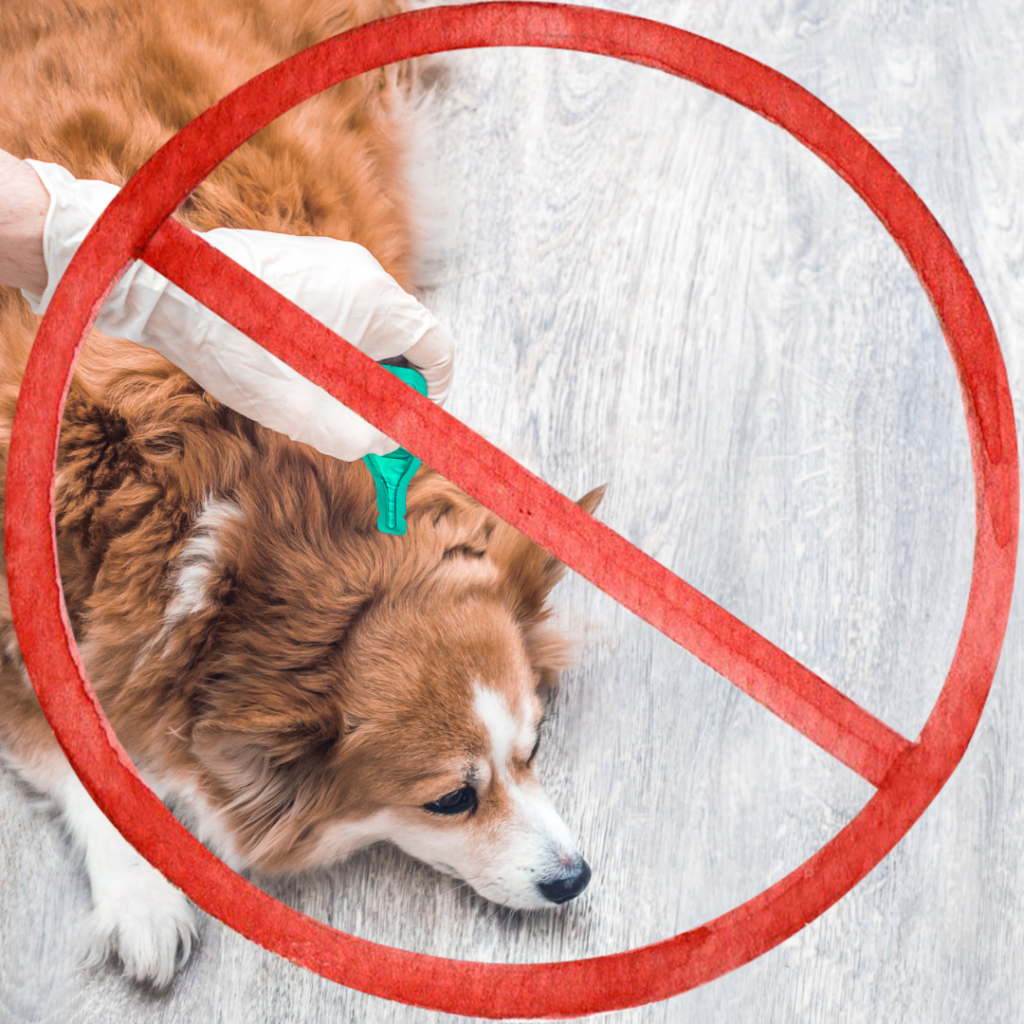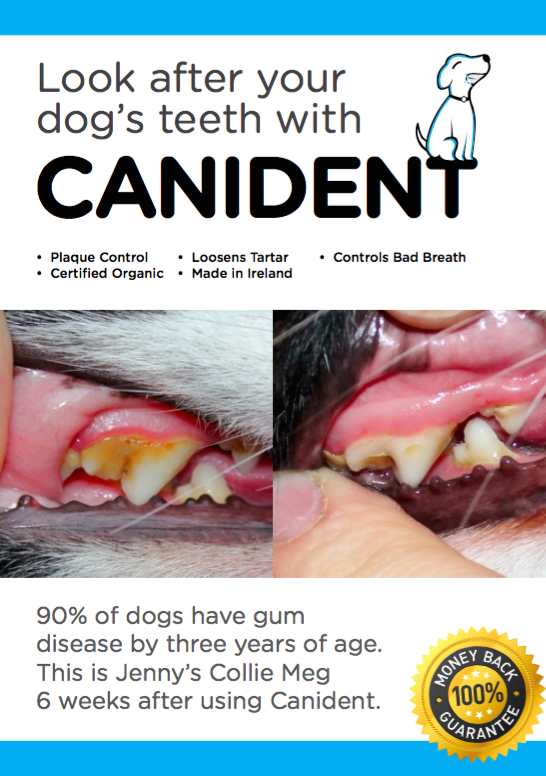We’re not insect haters here at Dogs First, but no one wants to share their lives with fleas or ticks. They can cause complete misery to any human or animal. Not only the irritation from a bite but the worry of tick-borne disease and the potential risk of actual tick-borne disease.
We want to control, prevent and treat fleas and ticks, but it has become a minefield. Sadly, many owners who choose conventional flea and tick treatments end up stepping on a mine with their pets, changing their lives forever.
That may sound dramatic, but we want to clarify we don’t recommend conventional flea and tick treatments as a first response because we have seen it go wrong many times.
How do conventional flea and tick treatments work?
So let’s look at how conventional flea and tick treatments work, the known side effects, safety concerns, environmental impact and whether better options are available.
Different types and brands
The flea and tick product market is huge. Year after year, new conventional flea and tick treatments are launched. For many decades we have watched the same ingredients appear in a shiny new product, and then companies suggest insects are developing a tolerance so a new ingredient appears.
At the time of writing (2023), there are two types of products for flea and tick control, tablets that are administered orally (we’ll call these oral products) and a topical fluid which is applied generally between the pet’s shoulder blades (we’ll call these spot-on products).
These products contain different active ingredients, and their mechanisms of action are slightly different.

Advantix
Products like Advantix contain the active ingredient Permethrin. Advantix is promoted to prevent and treat fleas, ticks, lice, sand flies, mosquitoes and stable flies. It’s a spot-on treatment.
Permethrin-containing spot-on formulations are designed so that the active ingredients will spread cutaneously in and on the dog’s skin with the “hope” of eventually covering the entire body surface. It’s important to note that some studies have shown, in some cases, that the legs and parts of the belly are not covered. Quickfire question time – where are fleas and ticks often found? On the undercarriage of many dogs.
But, for the sake of argument, let’s assume the permethrin gets where it needs to be. If it does, it’s absorbed into the insect directly through the outer cuticle or ingested while feeding on the dog. Permethrin then acts on the insect’s nervous system causing continuous nerve discharges. This results in restlessness, incoordination, tremor, paralysis, respiratory failure, and death.

Bravecto
Bravecto is more commonly used as an oral tablet but produces a spot-on product. They didn’t want pill-avoiders to miss out on the Bravecto party.
Fluralaner is the active ingredient in Bravecto. Fluralaner oral tablets are absorbed into the bloodstream and sent to the tissue under your dog’s skin. Fluralaner spot-on is absorbed into the skin and subsequently the bloodstream too. Fluralaner also works on the tick’s nervous system, causing hyperexcitability and death.
Whilst there is poor regulation of flea and tick products (we’ll come to that later), even the big boys at the FDA have issued warnings about these products.
In 2021, the FDA added the following statement to their fact sheet about Bravecto, Nexguard, Simparica and Credelio:
“The FDA is alerting pet owners and veterinarians of the potential for neurologic adverse events in dogs and cats when treated with drugs in the isoxazoline class.”
Bravecto is the most commonly discussed flea and tick product in the dog world; it even has its own group, which subsequently includes other products like Nexguard and Comfortis. It’s called Bravecto Nexgard Comfortis Simparica Trifexis & others. Do They Kill Dogs?
That’s not a typo – people are honestly asking whether these products are responsible for pet deaths worldwide.
There are a few more too:
A 2019 case study on a dog presenting with suspected neurological toxicity after ingesting Bravecto proposed an interesting concept. They suggest that fluralaner (the active ingredient) simply has a lower binding affinity to vertebrate receptors than arthropod receptors. Not that there isn’t one – just a slightly lower affinity. This suggests that fluralaner could still affect a vertebrate’s (that includes dogs) nervous system.

Frontline
Fipronil is found in products like Frontline, another spot-on treatment. Fipronil is not thought to be significantly absorbed from topical application sites but to translocate dermally, confined to the lipids of hair follicles and sebaceous glands. Fipronil also acts on the flea’s and tick’s nervous systems.
The other concern is that some data sheets, like Frontline, also suggest you shouldn’t touch your pet after administering:
“Treated animals should not be handled until the application site is dry, and children should not be allowed to play with treated animals until the application site is dry. It is therefore recommended that animals are not treated during the day. Still, it should be treated during the early evening, and recently treated animals are not allowed to sleep with owners, especially children.”
Is this a safe product if humans are advised not to touch their pets after administering it?
Fipronil
A review of studies on the safety of Fipronil was carried out, raising some interesting points.
Of 13 studies, the researchers made the following comments.
All dogs included were beagles.
All dogs were under the age of 1,
All dogs were purpose bred,
The study sizes were relatively small.
This must inform our interpretation of data. Do the results apply to all breeds? What about older dogs? Can we truly generalise to the dog population when the products have been tested on so few subjects?
Seresto
You will also come across flea/tick collars known as Seresto and alike. These collars are made of plastic and are impregnated with the active ingredients imidacloprid and flumethrin.
Imidacloprid also acts on the flea’s and tick’s nervous systems, like other products and flumethrin is thought to repel and kill ticks. If you have ever come across these products, you’ll be aware of the warning placed upon them:
“DO NOT LET CHILDREN PLAY WITH THIS COLLAR OR REFLECTORS; KEEP OUT OF REACH OF CHILDREN.”
So, we can put it on our pets, but we shouldn’t let our children touch it…
Despite this, the datasheet for Seresto collars suggests there is no risk of imidacloprid exposure to humans, and flumethrin exposure is below any level of concern.
However, they also state:
“The risk of the combination of the two active ingredients, flumethrin and imidacloprid, was not assessed because the two chemicals act in completely different ways.” So, we don’t officially have any data on the risk of BOTH ingredients together. Helpful.

Conventional flea and tick products can come in the form of collars, too
Seresto Controversy
Seresto drama has been brewing for several years, and it’s ongoing.
In 2022 the US House Subcommittee on Economic and Consumer Policy filed a 24 report on Seresto entitled: Seresto Flea and Tick Collars: Examining Why a Product Linked to More than 2,500 Pet Deaths Remains on the Market
After examining a wealth of evidence, their recommendations were as follows:
- Recalling Seresto collars
- Cancelling the collar’s registration
- Strengthen the EPA’s scientific review process
- Improve incident data collection
There has also been a class action lawsuit which alleges Seresto flea and tick collars are excessively dangerous for pets and humans.
They’re not beating around the bush, are they? In light of this action, you’d think the manufacturers would be getting worried… But it seems their typical response is simply, “No product is without risk.”
So, let us look at the risks and side effects of all chemical flea and tick products in more detail.
Caution when using on puppies, pregnant, and lactating dogs
The data sheets for all flea and tick products indicate they are safe for puppies and pregnant and lactating dogs.
Whilst researchers have a sadistic desire to overdose on puppies in their studies, have the products been tested in pregnant and lactating dogs?
A search for a Bravecto trial in pregnant and lactating dogs came up empty (maybe its need to know?). If you find one, let us know. We’ll always happily look at data.
Fipronil in pregnant and nursing bitches is interesting. Researchers concluded that the study is “acceptable” and “adequate” to support the use of fipronil in pregnant and nursing bitches. Do we want to use an “adequately” safe product on our pets?
This particular study separated the dogs into three groups.
- Group 1 – control – (no treatment)
- Group 2 – 1 dose
- Group 3 – 3 doses
These doses were administered before pregnancy, during pregnancy and through weaning.
Whilst the researchers didn’t find any significance:
- Group 1 reported no stillborn puppies and 4 dying between birth and weaning.
- Group 2 reported 4 stillborn puppies and 7 dying between birth and weaning.
- Group 3 reported 1 stillborn and 6 dying between birth and weaning.
Luck of the draw?
It’s also pertinent to note that the researchers only monitored the puppies for around 40 days after birth. Were there any prolonged side effects? Guess we’ll never know…

Potential harm to human foetuses
Whilst we’re on the subject of small developing bodies, let’s look at the risk to human babies and children.
Studies now report that the exact compounds found in flea and tick products are circulating in our children’s bodies.
We also have increasing data that exposure to various pesticides is associated with neurodevelopment challenges in children.
A 2014 study examined associations between autism spectrum disorder (ASD) in children and maternally-reported use of imidacloprid, a common flea and tick treatment for pets.
Their dataset included information for 262 typically developing control children and 407 children with ASD. Compared with exposure among controls, the odds of prenatal imidacloprid exposure among children with ASD were slightly higher. The researchers concluded with confidence that this concept needs further investigation.
In addition, a 2012 review of pesticide exposure in children concluded there are clear adverse neurodevelopmental and neurobehavioral outcomes associated with prenatal pesticide exposure. Furthermore, the administration of pesticides to pets was a significant source of exposure for mothers.
So not only do these products harm our pets, but they can harm us and our children too. The NRDC even has a database of flea and tick products, and when you filter for what to avoid using around children, most of the products on the market pop up.

Alarming studies now report that the exact compounds found in flea and tick products are circulating in our children’s bodies.
Risks and Environmental Impact of Conventional Flea and Tick Treatments
To rub a little more salt into the wound, these products also harm our environment and wildlife.
In a large UK study, 20 English Rivers were found to have high levels of fipronil and imidacloprid (Advantix). These chemicals can kill tiny aquatic insects, a crucial food source for fish and birds.
And before you say it, we have an inkling that it’s down to pet usage because no agricultural use of fipronil has been recorded in the U.K. after 2015, and none of the imidacloprid after 2016, with use in 2016 only minimal, according to the government Food and Environment Research Agency.
Additional studies in San Francisco Bay water treatment plants show that levels of both fipronil and imidacloprid routinely exceed toxicity values for aquatic invertebrates.
One teaspoon of these chemicals is enough to kill one-and-a-quarter-billion honey bees.
Dave Goulson, a University of Sussex biologist, notes that these flea and tick products are like “Novichok for insects’ referring to a nerve agent widely suspected to be used by the Russian government to kill political dissidents.

One teaspoon of these chemicals is enough to kill one-and-a-quarter-billion honey bees.
Lack of regulation and oversight
Given this information, you’d think these products would be tightly regulated so they couldn’t be overused or misused.
Well, you’d be wrong.
Whilst your vet may only sell you a product at certain intervals, flea and tick products can be bought from pet shops and supermarkets. These products have the same mechanism of action.
It’s just really important to keep an eye on the government websites, just in case they issue another warning for you to be “mindful” of (sounds very much like the Lepto debacle, in all fairness, in response to the thousands of adverse or fatal reactions, the manufacturers stated they would simply “monitor” the situation).
But also double check you’re looking in the right place. Earlier this year (2023), the EPA proposed to hand over oversight of roughly 600 parasite-prevention products used on pets to the FDA.
The EPA indicated in a new report that it needs more resources from its sister agency, the FDA, to efficiently and most effectively evaluate and monitor pet parasiticides.
The proposal to shift pet parasiticide oversight to the FDA comes as the EPA is immersed in an internal review of how it responded to tens of thousands of adverse-incident reports associated with Seresto flea and tick collars for dogs and cats.
So, they come with safety warnings; they pose a risk to our pets, us, our children and the environment. Are they even necessary?
Why chemical treatments are not necessary – The unlikelihood of fleas in dogs
Were you unlucky enough to have a nit nurse in your school when you were younger? Or do you remember sitting in the bath while your hair was smothered in foul-smelling lotion because you caught head lice?
We only ever treated kids if they had an active infestation.
A letter was sent home, we were checked, and if we needed treatment, we got it. We didn’t have a monthly spot applied to our necks or a tablet every three months.
Lice aren’t known to cause disease, but tick-borne disease risk isn’t significant either. Especially when you have a healthy dog.
Fleas are parasites, and parasites target weak, old and diseased animals. To this end, a healthy dog is the best protection against fleas and ticks.

Newton (Karen – Dogs First’s beloved dog) lived for 16 wonderful years with no conventional flea or tick chemicals from around two years old – never had a single flea or tick. This picture was taken when he was 14, content, shiny coated, free from parasites – powered by fresh food and no chemicals.
The power of a robust immune system – The story of a rescued Great Dane with demodectic mange…
We want to tell you the story of a rescued Great Dane.
Riddled with demodectic mange and a very ill old girl, a vet nurse took the Great Dane and stuck her in with her seven dogs.
She moved the dog to a fresh meat diet and followed a natural flea routine.
The dog was right as rain in weeks, bounding around, the picture of health, free of mange.
Even more interesting is that no other dog in her fresh-fed, chemical-free pack “succumbed” to mange.
When you support a dog to be the healthiest version of themselves, things start falling into place, and parasites aren’t that much of an issue.
So, alongside a healthy dog, are there any other tried and tested ways to control fleas and ticks that don’t come with the shopping list of side effects and dangers to our pets?
Well, you’re in luck. There are, and we’re going to share them with you.
If you want to learn more about repelling fleas and ticks using herbs and oils, check out our article 10 Best Natural Dog Flea Treatments [Ultimate Guide 2023]

There are lots of safe and natural alternatives for flea and tick prevention and treatment
Conclusion
We’ve already mentioned that a healthy dog is the best protection against parasitic infestation. Hence, it stands to reason that you want to know how to support your dog’s health in the best way possible, but that is another series of articles.
Your dog’s diet is a good place to start – are you feeding everything they need and avoiding what they don’t?
In addition, many parasitic issues indicate that all is not well under the immune system hood. Many things can compromise healthy immune responses in your dog, including stress, high toxin burden, poor rest and recovery, low nutrient availability (immune cells need certain things to do their job well) and more.
If you are flying the flag with natural alternatives but still are fighting these little critters, it may be time to book a consultation with us here at Dogs First.
We can assess what’s currently going on for your dog and develop a plan to optimise their health.
Is you dog itching but doesn’t have fleas? Join Dr Brady’s Canine Allergy course today!















